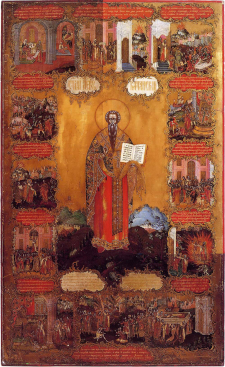Saint Leo, Bishop of Catania in Sicily

Saint Leo was born in Ravenna, Italy, of pious and noble parents. He was famed for his benevolence and charity, as well as his Christian love for the poor and wanderers. After completing his studies, he was ordained as a priest at Ravenna, and later, because of his purity and his most spiritual life, he was consecrated as Bishop of Catania in Sicily. He became the protector of orphans and widows, teaching and shepherding his flock.
The Saint was also distinguished for his struggles against heretics, whom he defeated and shamed, not only by his words, but also through his writings. The Lord honored him with the charisms of healing people from various diseases, and of working miracles.
During Saint Leo's episcopate, there was a sorcerer named Heliódoros who lived in Catania and deceived people with his fraudulent miracles. He was once a Christian, but then he denied the Savior and became a servant of the devil. Saint Leo urged Heliódoros to refrain from his evil deeds and return to God, but all in vain. One day Heliódoros audaciously entered the church where the bishop was performing the Divine Services, and tried to create a disturbance, sowing confusion and temptation with his sorcery.
Seeing the people beset by demons under the sorcerer's spell, Saint Leo knew that the time for meek exhortation had passed. He came out of the altar and tied his omophorion around the sorcerer's neck, leading him out of the church and into the city square. There he forced Heliódoros to confess all his wicked deeds. Then he commanded that a fire be lit, and jumped into the flames with the sorcerer. There they stood until Heliódoros was consumed by the fire. Saint Leo, by God's grace, remained unharmed. This miracle brought the Hierarch great renown during his lifetime, therefore, the Saint was invited to visit Constantinople by Emperors Leo IV (775 - 780) and Constantine VI (780 - 798), where he received many honors. Saint Leo reposed peacefully in 785.
After his death, a woman with an issue of blood received healing at his grave. The Saint's body was placed in the church of the holy Martyr Lucy (December 13), which he himself had built. Later on, his relics were transferred to the church of Saint Martin, the Bishop of Tours (November 11) in Rome.
